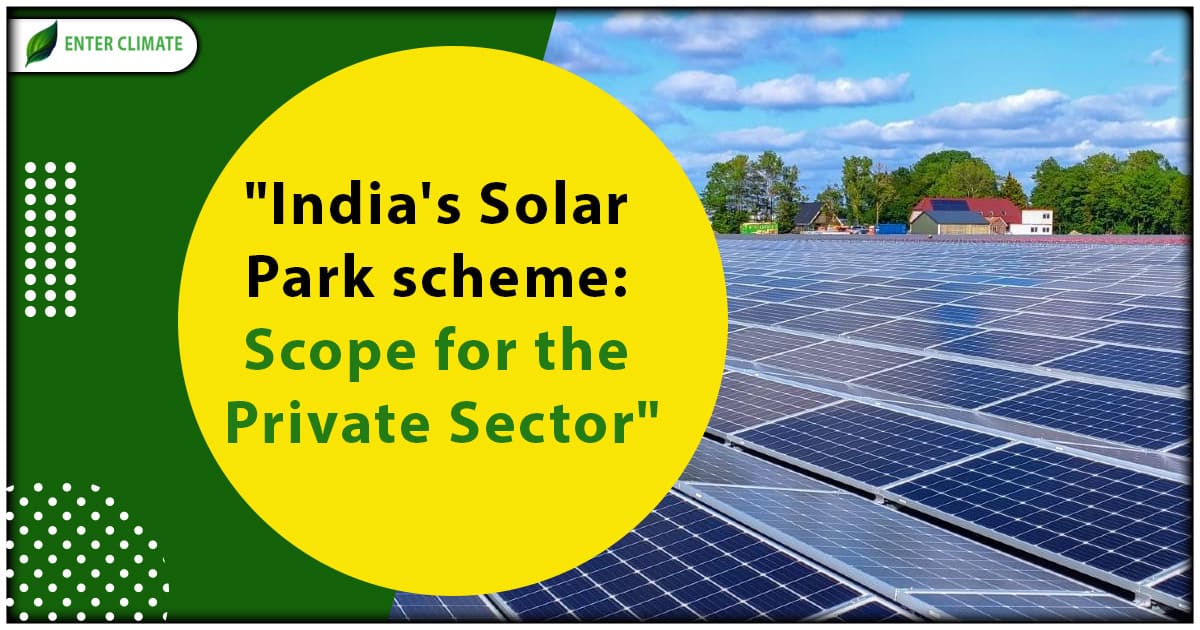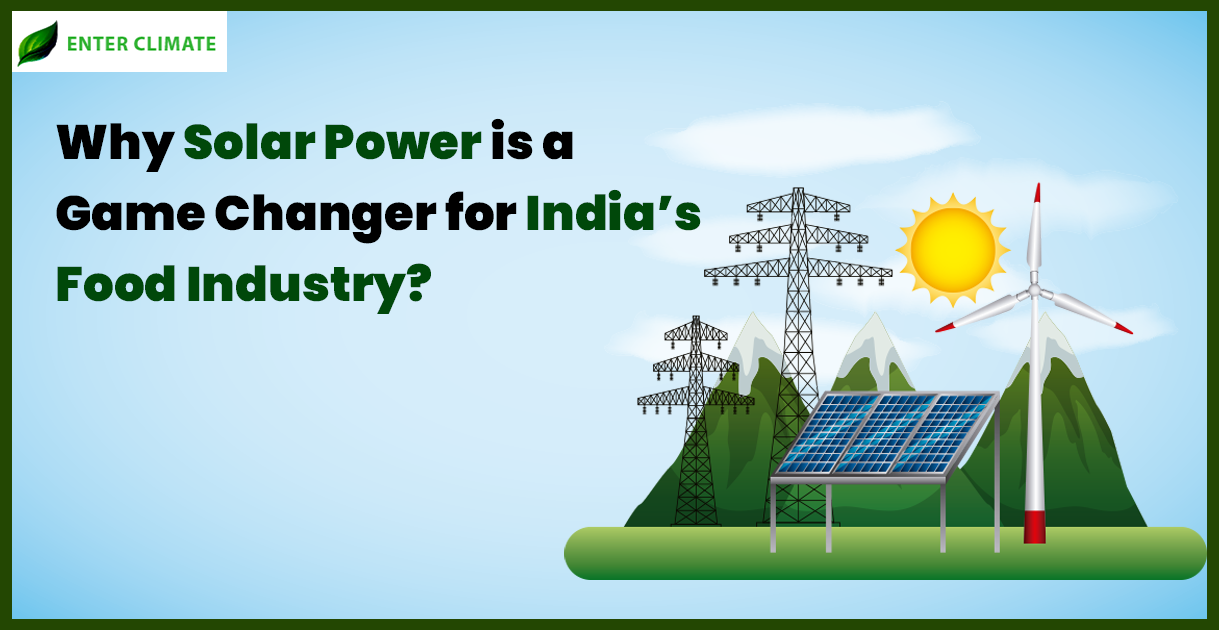India’s Solar Park Scheme: Scope for the Private Sector
 26 Jul, 2023
26 Jul, 2023 
Solar power projects have the flexibility to be established anywhere in the country; however, when they are developed in a scattered manner, it results in increased project costs per MW and higher transmission losses. This was one of the primary concerns and the reason for India’s solar park scheme. Implementing individual projects with smaller capacities incurs significant expenses in site development, necessitates separate transmission lines to the nearest substation, requires procuring water, and involves creating other essential infrastructure. Moreover, the process of acquiring land, obtaining various clearances and permissions, and fulfilling other regulatory requirements can be time-consuming, leading to project delays.
In response to these challenges, the government introduced the “Development of Solar Parks and Ultra-Mega Solar Power Projects” scheme. The Ministry of New & Renewable Energy (MNRE) introduced the Solar Park scheme on December 12 2014[1]. The primary objective of this scheme is to expedite the establishment of solar projects by providing a conducive environment for solar project developers. In this article, we will understand the long-term vision of the government in the solar energy sector and the scope for new public-private partnerships in this sector.
India’s solar park scheme: How is it Different?
A solar park as defined under India’s solar park scheme[2] is a vast expanse of land equipped with shared infrastructure facilities such as transmission infrastructure, roads, water supply, drainage, and communication networks, along with all the necessary legal approvals? This setup makes it hassle-free for solar project developers to establish their projects.
Key provisions of India’s solar park scheme are as follows:
- Initially, it aimed to establish a minimum of 25 Solar Parks and Ultra Mega Solar Power Projects, targeting 20,000 MW of solar power capacity over five years, starting from 2014-15.
- On 21-03-2017, the capacity of the scheme was increased from 20,000 MW to 40,000 MW, with the plan to establish these parks by 2023-24.
- The main purpose of India’s solar park scheme is to support various states and union territories in creating solar parks across the country. These parks provide well-developed land with all necessary approvals, transmission systems, water access, road connectivity, and communication networks. By doing so, the scheme expedites the installation of grid-connected solar power projects for large-scale electricity generation.
- The scheme is accessible to all states and union territories, and the solar parks are intended to have a capacity of 500 MW and above. However, smaller parks are also considered in areas where acquiring contiguous land is difficult due to challenging terrain or a shortage of non-agricultural land.
- The development of solar parks is a collaborative effort involving state governments, their agencies, central public sector undertakings (CPSUs), and private entrepreneurs.
Major Solar Power Park Projects in India
The major Solar Power Parks under India’s Solar Park scheme are as follows:
Bhadla Solar Park
- Bhadla Solar Park, situated in Bhadla, Phalodi tehsil, Jodhpur district, Rajasthan, India, holds the distinction of being the largest solar park globally, covering an extensive area of 14,000 acres.The impressive solar park boasts a total capacity of 2,245 MW.
Pavagada Solar Park
- The expansive Pavagada Solar Park, located in Pavagada taluk, Tumkur district, Karnataka, spans across 53 square kilometres (equivalent to 13,000 acres). And a capacity of 2,050 MW.
Kurnool Ultra Mega Solar Park
- The Kurnool Ultra Mega Solar Park, situated in Panyammandal of Kurnool district, Andhra Pradesh, encompasses a vast area of 5,932.32 acres, boasting an impressive capacity of 1,000 MW and is currently owned by Andhra Pradesh Solar Power Corporation Private Limited (APSPCL).
NP Kunta Ultra Mega Solar Park
- The NP Kunta Ultra Mega Solar Park, which is also referred to as the Ananthapuram Ultra Mega Solar Park, extends across an extensive area of 7,924.76 acres in Nambulapulakunta Mandal within the Ananthapur district of Andhra Pradesh, India.
Rewa Ultra Mega Solar
- Rewa Ultra Mega Solar represents a groundbreaking solar initiative in India, as it became the first solar project in the country to surpass the grid parity barrier.
Charanka Solar Park
- Under development in the northern Gujarat region, specifically near Charanka village in Patan district, Gujarat Solar Park-1, also known as Charanka Solar Park, occupies an extensive 2,000-hectare (4,900-acre) area of land.
Kamuthi Solar Power Project
- The Kamuthi Solar Power Project is a large-scale photovoltaic power station located in Kamuthi, Ramanathapuram district, approximately 90 km from Madurai, in the Indian state of Tamil Nadu. This solar project spans an expansive area of 2,500 acres.
Kadapa Ultra Mega Solar Park
- The Kadapa Ultra Mega Solar Park is an extensive solar park situated in the Mylavarammandal of Kadapa district, Andhra Pradesh, covering a vast area of 5,927.76 acres.
Ultra Mega Solar Power Projects under India’s solar park scheme
Ultra Mega Solar Power Projects, alternatively referred to as Ultra Mega Solar Parks, is an array of solar power initiatives envisioned by the Ministry of New and Renewable Energy under the Union Government of India.To facilitate the growth of solar energy, the Indian Government introduced a scheme in December 2014, aiming to establish a minimum of 25 solar parks and Ultra Mega Solar Power Projects with a cumulative capacity of over 20 GW of installed solar power. These solar projects receive financial support from the Central Government to aid their construction and development.
Opportunities for entrepreneurs in Private Sector
There are numerous opportunities for entrepreneurs in the solar sector in India, which has seen huge demand after the introduction of India’s solar park scheme. Below stated are some of the most promising ones:
- Solar Power Generation: A highly significant opportunity lies in solar power generation in India. The government has set an ambitious target of producing 500 GW of solar power by 2030, resulting in a surge of solar power plants across the country. Entrepreneurs can seize this chance by establishing new solar power plants or investing in existing ones.
- Solar Street Lighting: India’s extensive road network incurs significant expenses for municipalities regarding street lighting. However, solar street lighting presents a sustainable and cost-effective alternative. Entrepreneurs can tap into this opportunity by setting up solar street lighting systems.
- Solar Home Lighting Systems: Considering India’s substantial off-grid population, solar home lighting systems offer a cost-effective means of providing lighting to households without access to the grid. Entrepreneurs can venture into this opportunity by setting up solar home lighting systems.
- Solar Energy Consulting: The escalating demand for solar energy calls for expertise in consulting services for businesses and individuals investing in solar energy. Entrepreneurs with solar energy knowledge can capitalize on this opportunity by providing consulting services.
- EPC Services Engineering, Procurement, and Construction (EPC) services: EPC Services play a vital role in setting up solar power projects. With the rising number of solar power projects in India, the demand for EPC services presents a viable business opportunity.
- Solar Energy Monitoring and Analytics: Offering solar energy monitoring and analytics solutions, including remote monitoring systems and performance optimization services, can be a lucrative business opportunity in the Indian solar energy industry.
- Solar Education and Training: Entrepreneurs can capitalize on this opportunity by developing curricula, conducting training programs, and offering technical support.
- Solar Panel Manufacturing: India is rapidly becoming a focal point for solar panel manufacturing due to the government’s emphasis on increasing solar power capacity. As demand for solar panels rises, entrepreneurs can capitalize on this opportunity by establishing solar panel manufacturing units.
- Solar Water Pumping: Given India’s vast agricultural sector’s heavy reliance on groundwater for irrigation, solar water pumping systems offer a reliable and cost-effective solution in regions with unreliable electricity supply. Entrepreneurs can explore this opportunity by setting up solar water pumping systems.
Licenses and permits requiredby Solar Power Projects
The licenses and permits required in a solar sector business to avail of the subsidies and benefits introduced by the government under India’s solar park scheme are as follows:
- Business Registration– The initial step is to register the business as a legal entity, which could be a proprietorship under the Shop and Establishment Act, a limited liability partnership under the Limited Liability Partnership Act, 2008, or a company under the Companies Act, 2013.
- GST Registration– All businesses engaged in taxable supplies of goods or services are required to obtain GST registration. Businesses exceeding the turnover threshold of 20 Lakhs (for Services) must register and obtain a GST number.
- ISO Certification– To ensure service quality and build customer trust, obtaining ISO Certification is essential.
- Trademark Registration– To enhance the business’s reputation and recognition, it is advisable to acquire trademark registration for its services, thereby protecting the uniqueness of its offerings.
Documents Needed
- Power Purchase Agreement/ Solar Net Metering Agreement
- Land conversion from Agricultural to Non-Agricultural (if required)
- Fire NOC from Fire Department
- CEIG Approval (Approval from Chief Electrical Inspector)
- Accreditation of renewable energy generation projects for renewable energy certificate by the state agency.
- Connectivity Diagram and Single Line Diagram of Plant
Target of India’s solar park scheme
India has set ambitious goals to transform its energy landscape. By 2030, the country aims to achieve a non-fossil energy capacity of 500 gigawatts, with non-fossil energy accounting for 50 per cent of the total installed capacity. Furthermore, India is committed to reaching Net Zero carbon emissions by 2070.
As part of the National Solar Mission, the government has targeted the installation of 100 gigawatts of grid-connected solar power plants by the year 2022. To attain these objectives, various schemes have been launched to incentivize nationwide solar power generation. These schemes include the Solar Park Scheme, VGF Schemes, CPSU Scheme, Defence Scheme, Canal Bank & Canal top Scheme, Bundling Scheme, and Grid Connected Solar Rooftop Scheme, among others.
Modes of selection under India’s solar park scheme
The entity responsible for implementing India’s solar park scheme is known as the Solar Power Park Developer (SPPD). There are seven different modes through which the SPPDs can be selected. Under this scheme, the Ministry offers Central Financial Assistance (CFA) of up to Rs. 25 lahks per solar park to facilitate the preparation of a Detailed Project Report (DPR). Additionally, a CFA of up to Rs. 20.00 lakh per megawatt or 30% of the total project cost, including Grid-connectivity cost, whichever is lower, is also provided upon achieving the prescribed milestones in the scheme.
The modes for selecting SPPDs are as follows:
- Mode-1: The State designated nodal agency or a State Government Public Sector Undertaking (PSU) or a Special Purpose Vehicle (SPV) of the State Government.
- Mode-2: A Joint Venture Company of the State designated nodal agency and Solar Energy Corporation of India Ltd (SECI).
- Mode-3: The State designates SECI as the nodal agency.
- Mode-4: Private entrepreneurs with or without equity participation from the State Government.
- Mode-5: Central Public Sector Undertakings (CPSUs) like SECI, NTPC, etc.
- Mode-6: Private entrepreneurs without any Central Financial Assistance from the Ministry of New and Renewable Energy (MNRE).
- Mode-7: SECI acts as the Solar Power Park Developer (SPPD) for Renewable Energy Parks.
- Mode-8: CPSUs/state PSUs/Government organizations or their subsidiaries or joint ventures of the mentioned entities can also serve as SPPDs.
Other Solar Power schemes in India
To achieve its target of 500 GW of non-fossil fuel-based energy capacity by 2030, the MNRE has formed a committee comprising representatives from crucial agencies dealing with renewable energy and electricity. The following are some of the other solar power-related schemes in India.
- MNRE has approved two significant solar projects, namely the Omkareshwar Floating Solar Park (600 MW) and the Chhatarpur Solar Power Park (950 MW). These projects fall under the Ultra Mega Renewable Energy Power Parks (UMREPPS) mode and are part of the Solar Energy Park Scheme.
- In December 2018, the Atal JyotiYojana (AJAY) Phase-II was launched to install solar streetlights in remote, rural, and semi-urban areas.
- India is actively working on enhancing solar capacity and utilization, including initiatives such as providing clean-cooking solutions to 24-25 crore households through solar energy, installing solar panels on canals, and promoting solar trees in household gardens or balconies, which could potentially provide 15 per cent of energy for households.
Conclusion
India’s solar park scheme has emerged as a crucial and transformative initiative in India’s pursuit of clean and sustainable energy. With the establishment of solar parks and ultra-mega solar power projects across the country, the scheme has paved the way for efficient and large-scale solar energy generation. By providing essential infrastructure, financial support, and conducive environments for solar project developers, the scheme has accelerated the deployment of renewable energy sources, reduced the country’s carbon footprint and contributed significantly to its renewable energy goals. As solar parks continue to thrive and expand, India moves closer to achieving a greener and more sustainable future. It is highly recommended to consult an expert to know better about the government subsidies that would be applicable to the respective solar power projects.
FAQs
Situated in the Thar Desert of Rajasthan, India, the Bhadla Solar Park stands as a vast solar power plant, spanning 56 square kilometres. It boasts an impressive total installed capacity of 2,245 megawatts (MW), positioning itself as the world’s largest solar park as of the year 2023.
The Ministry of New & Renewable Energy introduced the scheme on December 12, 2014.
In India, there are several schemes dedicated to solar energy, including the Jawaharlal Nehru National Solar Mission (JNNSM), the Government Yojana: Solar Energy Subsidy Scheme, the Development of Solar Park Scheme, the UDAY Scheme, the SECI Scheme, and the Rooftop Scheme.
Bhadla Solar Park, situated in Bhadla, Phalodi tehsil, Jodhpur district, Rajasthan, India, holds the distinction of being the largest solar park globally, covering an extensive area of 14,000 acres.
Karnataka is renowned as the solar hub of India, boasting one of the highest capacities for solar power production in the country, with a remarkable total installed capacity of 7,597 MW as of June 2022.
The Gujarat Solar Park stands as India’s pioneering utility-scale solar park.
Modhera holds the distinction of being India’s inaugural solar-powered village, where residents’ electric bills are covered.
Bhadla, the second-largest solar farm globally, boasts an impressive capacity of 2.7 GW, and it extends across a vast area spanning 160 km.
The state of Punjab, specifically in Amritsar, witnessed the inauguration of India’s inaugural commercial solar power plants.
Modhera, situated in the state of Gujarat, holds the distinction of being India’s pioneering solar-powered village.
Read our Article: Everything You Should Know About Solar Project Financing
Categories
Latest Post
Air pollution Dispersion Modeling
Natural Disaster Risk Assessment
Endangered Species Protection
Aquifer Recharge Project
Sustainable Sanitation Solutions














